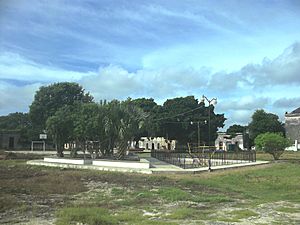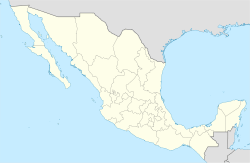Hacienda Cacao facts for kids
Quick facts for kids
Hacienda Cacao
|
|
|---|---|
|
Village
|
|

Principal park at Cacao
|
|
| Country | Mexico |
| Mexican States | Yucatán |
| Municipalities | Abalá |
| Time zone | UTC−6 (CST) |
| • Summer (DST) | UTC−5 (CDT) |
| Postal code |
97826
|
| Area code | 988 |
Hacienda Cacao is a historic village located in the Abalá Municipality in Yucatán, Mexico. It is found off the Uman-Hopelceh highway, in the southwest part of the Yucatán State. This area was once a large farm or estate, known as a hacienda. Hacienda Cacao became important during the 1800s because of the henequen plant.
Contents
What's in a Name?
The name "Cacao" comes from the Mayan word ka'kaw. This word means "cocoa" in the Mayan language. Cocoa is the plant used to make chocolate!
A Look at Hacienda Cacao's Past
Hacienda Cacao was built by a man named José María Ponce. He was a very clever businessman. In 1889, he even made his own special tokens for the hacienda. These tokens are now very valuable to people who collect old coins.
José María Ponce grew a plant called henequen on his farm. Henequen is a type of agave plant. Its strong fibers are used to make rope and other products. He was very good at selling this fiber, also known as sisal. With the money he earned, he started other businesses. He owned an ice factory, a chocolate factory, and even a brewery.
In 1918, a special party was held at the hacienda. A musician named Enrique Galaz Chacón wrote his first song there. It was a bolero called Madrigal. This song is known as the first bolero from Yucatán.
Nearby X'batún Cave
South of Mérida, near Hacienda Cacao, there is a small village called San Antonio Mulix. Close by is the amazing X'batún Cave. This cave is about 100 meters long. Its entrance is 3.60 meters wide and 2.50 meters high.
Long ago, the entrance to the cave was blocked by a stone wall. Today, this wall has fallen down. Archaeologists have found interesting things inside the cave. The last part of the cave has a pool of water about 15 meters long.
Changes to the Hacienda's Name and Location
Over the years, the name and official location of Hacienda Cacao changed a few times:
- In 1921, its name was changed to Cacán Cacau.
- In 1930, it became Cacao again. At this time, it moved from Abalá to the Uman municipality.
- In 1936, Hacienda Cacao returned to the Abalá municipality.
People of Cacao
Before 1937, many people lived and worked on the henequen farms. But then, a big change happened in Mexico. President Lázaro Cárdenas started a land reform program in 1937. This program changed large haciendas into collective farms called ejidos. This meant the land was shared by the community. The original landowners were allowed to keep only a small part of their property, about 150 hectares.
Because of this change, the population numbers changed. Before 1937, the numbers showed people living on the farm. After 1937, they showed people living in the community. Today, only the owner's family lives in the main Hacienda Cacao houses.
According to a census in 2005, the village of Cacao had 261 people living there. This included 142 men and 119 women.
| Year | 1900 | 1910 | 1921 | 1930 | 1940 | 1950 | 1960 | 1970 | 1980 | 1990 | 1995 | 2000 | 2005 |
|---|---|---|---|---|---|---|---|---|---|---|---|---|---|
| Population | 312 | 345 | 351 | 199 | 233 | 359 | 400 | 435 | 442 | 234 | 206 | 235 | 261 |
Gallery
See also
 In Spanish: Cacao (Abalá) para niños
In Spanish: Cacao (Abalá) para niños










